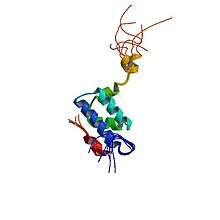Translocase of the outer membrane
The translocase of the outer membrane (TOM) is a complex of proteins found in the of the . It allows movement of proteins through this barrier and into the intermembrane space of the mitochondrion. Most of the proteins needed for function are encoded by the nucleus of the cell. The outer membrane of the mitochondrion is impermeable to large molecules greater than 5000 Daltons. The TOM works in conjunction with the translocase of the inner membrane (TIM) to translocate proteins into the . Many of the proteins in the TOM complex, such as TOMM22, were first identified in Neurospora crassa and Saccharomyces cerevisiae.
The complete mitochondrial protein translocase complex includes at least 19 proteins: several chaperones, four proteins of the outer membrane translocase (Tom) import receptor, five proteins of the Tom channel complex, five proteins of the inner membrane translocase (Tim) and three "motor" proteins.
There are various mitochondrial import pathways that exist to facilitate the import of precursor proteins to their destined mitochondrial subcompartments. HSP90 aids the delivery of the mitochondrial preprotein to the TOM complex in an ATP-dependent process. Many precursor proteins (those that are destined for the matrix) contain amino-terminal presequences that carry information required for the targeting of proteins to the These matrix targeting signals generally contain 10-80 amino acid residues that take on the conformation of an amphipathic-α helix and contain one positive and hydrophobic face. Once the precursor reaches the matrix, the presequence is typically cleaved off by the matrix processing peptidase. Proteins targeted to other sub-compartments of the mitochondria such as the intermembrane space and , contain internal targeting signals, these signals have an indefinable nature and are inconsistent in their pattern. Proteins targeted to the outer membrane also contain internal targeting signals, not all of which have been identified, and include proteins that take on a β-barrel structure, such as Tom40. Some proteins however, that are targeted to the outer mitochondrial membrane contain a hydrophobic tail domain that anchors the protein to the membrane.
...
Wikipedia

